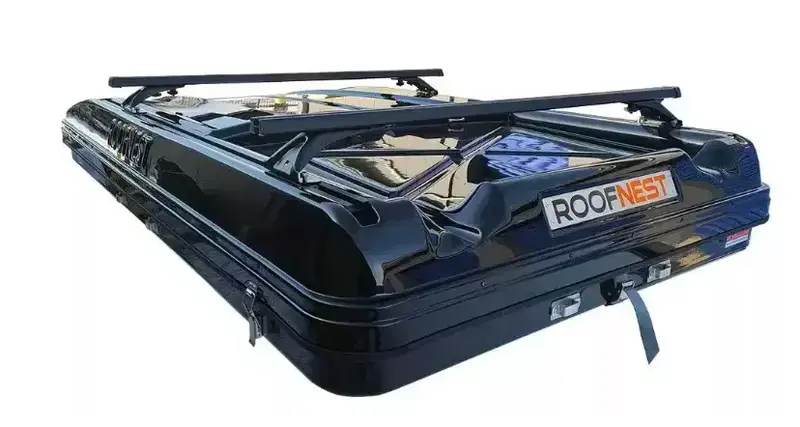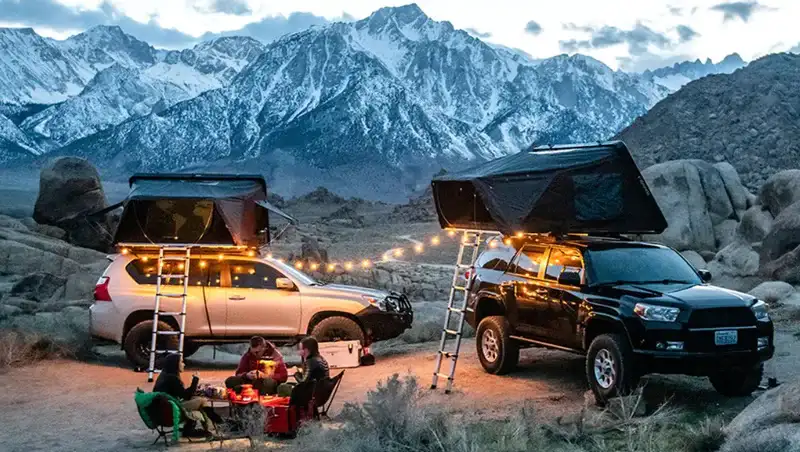Hard shell roof top tents are becoming increasingly more popular in spite of their steep prices. But there are some good reasons for this, you will find them described here in detail.
A hard shell roof top tent is an off-ground sleeping shelter which, when packed, stores in its own solid box that includes a bottom part and a lid.
There are two major types of hard shell roof top tents:
- Pop-up hard shell roof top tents.
- Clamshell hard shell roof top tents.
The main difference between them is when they are used as a shelter. In a pop-up type, the lid raises up and becomes the roof of the tent. In a clamshell type, the lid opens to the side and creates a solid angled side wall.
What is the roof top tent’s hard shell material?
In principle there are no general differences regarding the two main types mentioned above.
Typically, the materials used in the construction of these hard shell rooftop tents include the following:
- Aluminum.
- Fiber-reinforced polymer or FRP.
- ASA/ABS synthetic hard shell combination.
- Combination of aluminum and these synthetic materials.
Aluminum: There is no doubt this is the best option. Aluminum is a lightweight yet strong metal, and it is also resistant to rust and corrosion. Compared to those synthetic materials, it is less likely to crack or break, but it is heavier.
You can see such an all-aluminum tent construction in the Roofnest Condor Overland, and also in the TentBox Cargo.
Having an aluminum hard shell roof top tent is good also because of the attachment options. Namely, such boxes may have side channels for the attachment of cross bars. This means that you can transport some bulky items on the top of your roof top tent.
Both tents mentioned in the previous paragraph have that feature. You can see this also in the OVS Mamba clamshell roof top tent.
Fiber-reinforced polymer or FRP: Aluminum is sometimes used in combination with synthetic materials. So you can have it used for the bottom, and the lid is then one of the two synthetic materials.
You can see such example in the iKamper BDV Blue Dot Voyager Duo. The lid of this tent is a FRP.
The iKamper BDV Duo offers 2.9 square meters, and it weighs 150 pounds (68 kg). In the Roofnest Falcon Pro (which is made of aluminum) you have 2.7 square meters, and it is heavier with its 180 pounds (82 kg). This is 20% more weight.
This FRP material is lightweight, strong, and durable regarding UV exposure. But in principle, it can be prone to cracking or breaking if exposed to extreme temperatures or impacts.
ASA/ABS synthetic hard shell combination: One typical example of this type is the Roofnest Sparrow Eye RTT. If you follow the link you will see it compared with the mentioned TentBox Cargo which is built from aluminum. Now, they both have the same size area, but the aluminum RTT is 36% heavier.
This is one of the reasons why you might want to consider such a synthetic material. If your car cannot support a heavy RTT, you will have to go for a lighter option.
So in general, such composite materials give a great combination of strength and durability from one side, and weight from the other side.
Do you remember what I said about attachment and cross bars regarding aluminum RTT? Well, some great examples of ASA/ABS roof top tents can also offer this. You can see it in the Roofnest Sparrow Adventure XL shown in the picture below.

How about walls of a hard shell roof top tent?
The walls of a hard shell RTT are normally a fabric. It is interesting that there are now some off-ground shelters designed to be used on vehicles, that are with solid walls. Clearly, you cannot describe them as tents.
Regarding the fabric, this is independent on the box used for a RTT. Many of them are built from a very durable polycotton material. How durable? Well, you can find some with 280, 300, or 320 grams per square meters. Examples of these are in the links given in the text above, but see also these Roofnest tents as an example.
Some are built from nylon, you have this in the BadAss Rugged Clamshell RTT.
However, there are some exceptional designs with 3-layer walls. They include two layers of polyester and a layer of polycotton in between. You can see this in several RTT of the Freespirit Recreation brand. Their Aspen RTT is one of them, and the Evolution as well. I am sure that currently there is nothing better on the market.
What is the difference between a hardshell and a softshell rooftop tent?
This is a topic that would deserve a completely separate text. But here, I would point out the following only in terms of comparison between the two types.
Hardshell rooftop tents
- They have a rigid shell, you have seen everything about it above.
- These RTT are usually with a streamlined profile and easier to setup and to takedown.
- They are generally more durable and weather-resistant than softshell tents.
- You can expect a better insulation and soundproofing in them than in softshell tents.
- Unfortunately, they are much more expensive than softshell tents.
- They are normally heavier.
Softshell rooftop tents
- They may have a solid bottom but the top is covered for transportation with a thick fabric.
- These tents have a fabric canopy that folds out to create the sleeping area. So soft shell roof top tents are always expandable. This makes them different from hard shell RTT where only some clamshell models may be expandable.
- The canopy of soft shell RTT is supported by strong poles or a frame.
- They are more affordable and lighter than hard shell RTT.
Summary
So you have seen some examples of hard shell roof top tents presented here and also in the links given in the text. These are off-ground types of shelters that are the easiest to use of all. Almost equally easy it is to close such a tent and to have it ready for the drive.
But this type is also the most expensive of all off-ground tents, this is a fact. They can be heavy and not suitable for just any car. There are weight limits to consider.
Let me know if you have questions, there is a comment box below. Check out also my another text about avoiding condensation in RTT.
Bookmark this site and keep as a reference, you will always have new texts about off-ground tents added here. Thank you for reading and have a nice day.

